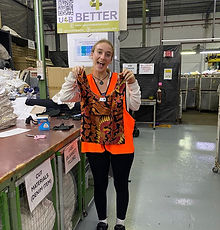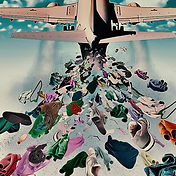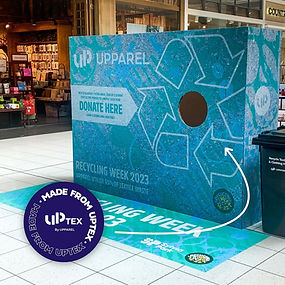New Zealand
- Written by Elise
Which kind of waste bins do you have in your household?

A red lid bin for general household rubbish, a yellow lid bin for cardboard, paper and certain plastics, a green lid bin for compost, leaves, organic matter,a small green food-scraps bin (recently introduced and only in the cities), and a blue or green tub for glass, cans and other recyclable materials.
The new Tauranga City Council rubbish bin and recycling bin line-up. Photo / George Novak

What would you say is the general attitude toward secondhand clothing in your country?
New Zealand is big on op-shops and second-hand clothing stores, especially in major cities such as Auckland, Wellington and Christchurch. In Wellington, our main shopping street is lined with many thrift-stores which are generally seen as more popular and ‘trendy’ to shop at than the fashion chains. Second-hand pop up shops are often found on university campuses, as well as ‘clothes swap’ events hosted by universities and communities.
Where do people usually buy or sell secondhand clothes?
Charity shops and general thrift stores are the most popular places to buy and sell second-hand clothes. Some popular secondhand clothing chains include ‘Paperbag Princess’, ‘Recycle Boutique’, ‘Spacesuit’, ‘Savemart’, and ‘Salvation Army.’ We also have many popular online secondhand stores including ‘Walk in Wardrobe’ and ‘Trademe clothes.’

Recycle Boutique, a second-hand clothing store in Auckland. (Image: Heart of the City)
How many pieces of clothes does the average person in New Zealand own?
There isn’t any definitive answer for New Zealand specifically, but it is estimated that the average person has around 148 items of clothing in their wardrobe.
What is one thing that your country could learn from Malaysia/ U4B?
Just how much time, effort and money goes into keeping a single item of clothing out of landfill, and how detrimental the fast-fashion industry is to the environment. If everyone could see how many clothes are being sorted and upcycled in the U4B factories that would otherwise be put in landfill, I think we would all think a little differently about buying and throwing away clothes.
Which facts shocked you during your research?

The fast fashion emits more CO₂ overall than aviation and shipping industries combined . So much stigma is put on airplanes and aviation companies (and rightly so!) for their carbon emissions, but the fast fashion industry is much worse for the environment overall.
The aviation industry accounts for 2.5-3.5% of all Greenhouse Gas emissions, whereas the fast-fashion industry accounts for 8-10%. Not to mention, the fast-fashion industry also causes water pollution, microplastics and landfill waste.
Flying goods on planes can create 100 times more carbon emissions than sending them the same distance on ships. Illustration: Tony Bell
What are some national campaigns or organizations in your country promoting textile recycling or reuse?
UsedFULLY is a programme designed for businesses and organisations that produce, supply or uses clothing or textiles that want to be more sustainably and make a positive environmental difference. They’ve designed a circular system for clothing in NZ to ensure each item is used to it’s full potential. They[ve also delivered a six-part plan, or ‘white paper’ to the government, calling for them to join with industry and lead a strategic approach to implementing meaningful and practical solutions to textile waste at a large scale.
ImpacTex is a wholly NZ-owned textile recovery business that offer tailored solutions for businesses to contribute to using textile waste. They offer services such as sorting, donating re-saleable items to charities, and transforming end-of-life textiles into 100% recycled and recyclable panels for acoustic, signage, packaging, and more.
Since early 2022, they've diverted hundreds of tonnes of textile waste and hundreds of thousands of kilograms of CO₂ from landfills.Mindful Fashion NZ is a not-for-profit promoting sustainable fashion and textile circularity in New Zealand. It’s an established ‘circularity working group’ that steers industries towards reusing and reducing waste.They also organises annual awards recognizing circular design excellence, such as the Circular Design Award given to Untouched World’s “Rubbish Socks”—made from recycled knit waste blended with merino.
Award-winning Rubbish Socks by Untouched World, made from recycled yarn and leftover knitwear. (Image: Untouched World)

What kind of textile waste recycling points exist in New Zealand?
ImpacTex
Operates across NZ with collection services, sorting donations for reuse or recycling into industrial materials like signage or insulation panels. Works with businesses and councils (e.g., Auckland Council) to repurpose uniforms.

Textile Products Ltd – Retex
Based in Onehunga, Auckland—accepts textile waste (any condition), removes hardware, and turns it into recyclable building and industrial materials. They also offer workplace “Takeback Recycling” pods.
Little Yellow Bird (Cotton Program)
Specialises in collecting 100% cotton, merino, wool, linen, hemp, and silk textiles—including socks, sheets, and jeans. Uses prepaid take-back bags and fibers are chemically recycled into new textile.
Upparel
Accepts clean textiles nationwide for sorting into reuse, upcycling, or repurposing. Also offers branded collection bins, freight logistics, and flexible collection options.
Recycling station constructed entirely from textile waste. (Image: Instagram / @upparelofficial).
How much textile waste is generated in New Zealand? How much ends up in landfills, how much is recycled?
It’s estimated that New Zealand produces an annual volume of 220,000 tonnes of textile waste, and of that, around 180,000 tonnes is sent to landfill. That’s about 34 kg per person annually, or 3.5 tonnes every 10 minutes.
Op shops and charities typically manage only 15–30% of the donated clothing—a large share is unsellable and ultimately ends up in landfill.
Unsellable donations often get exported—especially to the Pacific, including Papua New Guinea. However, about 50% of items that cannot be sold or reused go directly to landfills.
Only a small fraction (12%) of textiles are diverted through donation or recycling, and less than 1% are broken down and regenerated into new clothing fibres.
References
How much clothing do people own? (n.d.). Capsule Wardrobe Data. https://capsulewardrobedata.com/howmuchclothingdopeopleown
Fast fashion industry emits more carbon than the aviation and shipping industries combined (Current Issue No.3503). (2024). KASIKORN RESEARCH CENTER. https://www.kasikornresearch.com/en/analysis/k-econ/business/Pages/FastFashion-CIS3503-KR-07-06-2024.aspx
I'm a paragraph. Click here to add your own text and edit me

